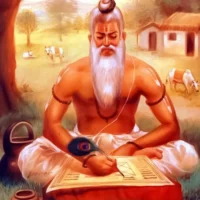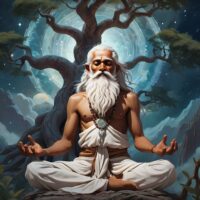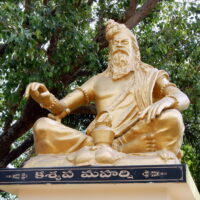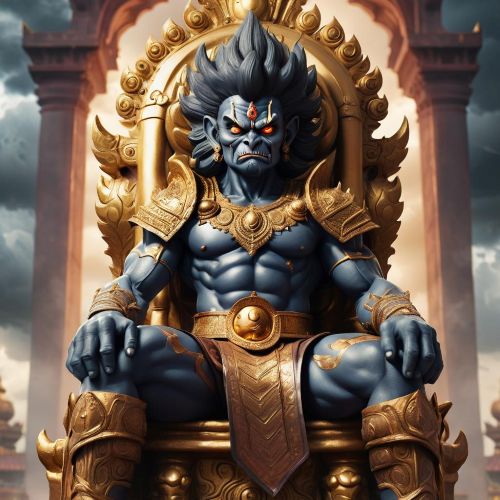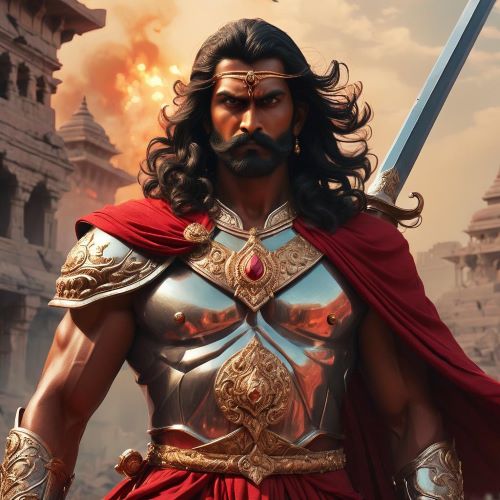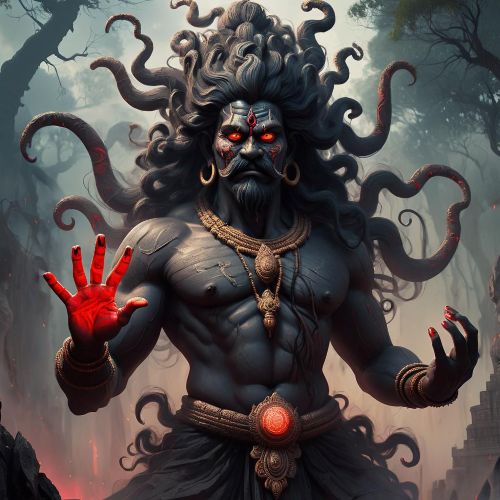Kashyapa : The Immortal of Creation
Listen
At a glance
| Description | |
|---|---|
| Origin | Indian Mythology |
| Classification | Mortals |
| Family Members | Marichi (Father), Aditi, Diti, Kadru, Vinata, Surabhi, Tamra, Krodhavasha, Ila, Muni (Wives) |
| Region | India |
| Associated With | Creation, Human Race |
Kashyapa
Introduction
Kashyapa is one of the most celebrated sages in Hindu mythology, revered for his unmatched wisdom and his pivotal role in the creation and sustenance of life across the universe. Regarded as one of the Saptarishis, or Seven Great Sages, he occupies a central position in Vedic, Puranic, and epic literature. His influence stretches far beyond his own lifetime, shaping the divine and mortal worlds alike. In Hindu cosmology, Kashyapa is not just a teacher or philosopher but also a progenitor whose unions with numerous consorts gave birth to gods, demons, celestial beings, animals, and humans. Through him, the intricate web of existence in Indian mythology finds both structure and diversity, making him a figure whose presence resonates in both spiritual thought and cultural tradition.
Physical Traits
While scriptures rarely offer detailed physical descriptions, Kashyapa is typically imagined as a serene ascetic, with a long flowing beard and radiant countenance that reflects his inner enlightenment. His attire is simple—bark garments or cotton robes—symbolising his detachment from material life. Often depicted seated in meditation or teaching, with a water pot and staff by his side, he embodies the image of a Brahmarshi, a sage who has attained the pinnacle of spiritual wisdom. The etymology of his name, meaning “tortoise” in Sanskrit, has inspired symbolic interpretations, associating him with patience, longevity, and stability—qualities that define both his character and his role in mythology.
Family
Kashyapa’s lineage is monumental in scope, making him one of the most significant patriarchs in Hindu mythology. He is widely recognised as the son of the sage Marichi, who himself was born from the mind of Brahma, the Creator. This divine heritage positions Kashyapa as Brahma’s grandson in most traditions, though some texts portray him as Brahma’s direct son. His family connections extend to some of the most powerful and symbolic figures in the mythological world through his many marriages, most notably to the daughters of Daksha Prajapati.
The exact number of Daksha’s daughters married to Kashyapa varies between scriptures—eight according to the Ramayana, thirteen in the Vishnu Purana, and in some scholarly interpretations, as many as twenty-one. Among his most prominent consorts were Aditi, the mother of the Devas; Diti, the mother of the Asuras; Kadru, who gave birth to the Nagas; and Vinata, the mother of Garuda and Aruna. Others, like Surabhi, Tamra, Krodhavasha, Danu, and Muni, were progenitors of entire classes of beings ranging from cattle and birds to divine sages and mystical entities. Through these unions, Kashyapa’s offspring came to populate the heavens, the earth, and the underworld, embodying the cosmic principle of diversity and balance.
Other names
Throughout the vast body of Hindu literature, Kashyapa is referred to by several honorifics and epithets that reflect his many roles. He is often called Prajapati Kashyapa, emphasising his position as a creator and progenitor of life. In some texts, he is addressed as Kashyapa Muni or Kashyapa Maharshi, titles that underscore his sagehood and spiritual authority. The Ramayana refers to him as Arishtanemi, while in Buddhist Pali texts he appears as Kassapa, one of the ten ancient seers whose wisdom shaped early religious thought.
His name has also been preserved in geography—most notably in the name “Kashmir,” believed by tradition to have been derived from Kashyapa Mira (lake of Kashyapa) or Kashyapa Meru (sacred mountain of Kashyapa). Ancient Greek records from Alexander the Great’s campaign mention “Kasperia” and “Kaspatyros,” believed to be transliterations of Kashyapa-related place names, further testifying to his far-reaching cultural influence.
Powers and Abilities
Kashyapa’s strength lies not in martial might but in spiritual mastery. He is described as possessing Tapas Shakti, the transformative power gained through deep meditation, enabling him to shape reality itself. His knowledge of sacred rituals and mantras, or Mantra Shakti, allowed him to perform acts of creation and protection on a cosmic scale.
Legends credit him with composing hymns in the Rigveda, particularly in Mandala IX, celebrating the purifying power of Soma. His role as a mediator between Devas and Asuras highlights his impartial wisdom, ensuring that cosmic order, or dharma, was maintained. One celebrated legend tells of Kashyapa draining the great lake that once covered the Kashmir valley, making it habitable—a feat often interpreted symbolically as the removal of ignorance to make way for civilisation and learning.
Texts attributed to him expand his influence beyond mythology into practical sciences. The Kashyapa Samhita, a foundational text of Ayurveda, is one of the earliest treatises on paediatrics, obstetrics, and gynaecology. His works are also said to have covered architecture (Kashyapashilpa), music (Kashyapasangīta), and philosophy (Kashyapa Jnanakanda), though some have been lost to time, surviving only in quotations by later scholars.
Modern Day Influence
The figure of Kashyapa continues to inspire Indian thought, culture, and spiritual practice. In the traditional gotra system, many Brahmin families trace their lineage directly to him, a testament to his enduring genealogical significance. His teachings in Ayurveda remain relevant in the study of traditional medicine, especially in the field of child health, where the Kashyapa Samhita is still referenced.
In a broader philosophical sense, Kashyapa’s legacy reinforces the idea of harmony in diversity—a principle as relevant in modern society as it was in ancient cosmology. His progeny, spanning gods and demons, animals and humans, symbolise the coexistence of opposites within a balanced universe. This message resonates with modern movements advocating for ecological preservation, cultural inclusivity, and peaceful coexistence.
His story also carries metaphorical depth for contemporary life. The draining of the Kashmir valley can be seen as a call to remove ignorance and make space for growth, both intellectual and societal. In popular media, Kashyapa’s image appears in television adaptations of the Ramayana and Mahabharata, and his story is often revisited in spiritual discourses and academic studies, keeping his memory alive for new generations.
Related Images
Source
Doniger, W. (2009). The Hindus: An Alternative History. Penguin Books.
Basham, A. L. (1954). The Wonder That Was India. Grove Press.
Bhattacharyya, N. N. (1996). History of Indian Cosmogonical Ideas. Munshiram Manoharlal Publishers.
Dalal, R. (2010). Hinduism: An Alphabetical Guide. Penguin Books India.
Vettam, M. (1995). Puranic Encyclopaedia. Motilal Banarsidass.
Apam Napa. (n.d.). Kashyapa – Father of the Devas and Asuras – Indian Mythology. Apam-Napat. Retrieved August 15, 2025, from https://apam-napat.com/entities-kashyapa/
Mythology Worldwide. (2024, March 2). The Myth of Sage Kashyapa: The Father of Devas, Asuras, and Humans. MythologyWorldwide.com. Retrieved August 15, 2025, from https://mythologyworldwide.com/the-myth-of-sage-kashyapa-the-father-of-devas-asuras-and-humans/
Divine Hindu. (n.d.). Sage Kashyapa: The Divine Father of All Creatures. DivineHindu.com. Retrieved August 15, 2025, from https://divinehindu.com/sages/sage-kashyapa-the-divine-father-of-all-creatures/
Acharya Ganesh. (n.d.). Explore Awesome The Sage Kashyapa: His Vedic Legacy You Need To Know. AcharyaGanesh.com. Retrieved August 15, 2025, from https://acharyaganesh.com/rishis/kashyapa
Wikipedia contributors. (n.d.). Kashyapa. Wikipedia. Retrieved August 15, 2025, from https://en.wikipedia.org/wiki/Kashyapa
Frequently Asked Questions
What is lorem Ipsum?
I am text block. Click edit button to change this text. Lorem ipsum dolor sit amet, consectetur adipiscing elit. Ut elit tellus, luctus nec ullamcorper mattis, pulvinar dapibus leo.
What is lorem Ipsum?
I am text block. Click edit button to change this text. Lorem ipsum dolor sit amet, consectetur adipiscing elit. Ut elit tellus, luctus nec ullamcorper mattis, pulvinar dapibus leo.
What is lorem Ipsum?
I am text block. Click edit button to change this text. Lorem ipsum dolor sit amet, consectetur adipiscing elit. Ut elit tellus, luctus nec ullamcorper mattis, pulvinar dapibus leo.
What is lorem Ipsum?
I am text block. Click edit button to change this text. Lorem ipsum dolor sit amet, consectetur adipiscing elit. Ut elit tellus, luctus nec ullamcorper mattis, pulvinar dapibus leo.
What is lorem Ipsum?
I am text block. Click edit button to change this text. Lorem ipsum dolor sit amet, consectetur adipiscing elit. Ut elit tellus, luctus nec ullamcorper mattis, pulvinar dapibus leo.


